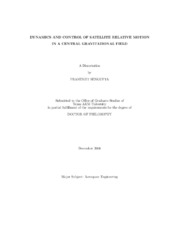| dc.description.abstract | The study of satellite relative motion has been of great historic interest, primarily
due to its application to rendezvous, intercept, and docking maneuvers, between
spacecraft in orbit about gravitational bodies, such as the Earth. Recent interest in
the problem of satellite formation flight has also led to renewed effort in understanding
the dynamics of relative motion. Satellite formations have been proposed for
various tasks, such as deep-space interferometry, and terrestrial observation, among
others. Oftentimes, the rich natural dynamics of the relative motion problem near a
gravitational body are exploited to design formations of a specific geometry.
Traditional analysis models relative motion under the assumptions of a circular
reference orbit, linearized differential gravity field (small relative distance), and
without environmental perturbations such as oblateness effects of the attracting body,
and atmospheric drag. In this dissertation, the dynamics of the relative motion
problem are studied when these assumptions are relaxed collectively. Consequently,
the combined effects of nonlinearity, eccentricity, and Earth oblateness effects on
relative motion, are studied. To this end, coupling effects between the various environmental perturbations are also accounted for. Five key problems are addressed
- the development of a state transition matrix that accounts for eccentricity,
nonlinearity, and oblateness effects; oblateness effects on averaged relative motion;
eccentricity effects on formation design and planning; new analytical expressions for
periodic relative motion that account for nonlinearity and eccentricity effects; and
a solution to the optimal rendezvous problem near an eccentric orbit. The most
notable feature of this dissertation, is that the solutions to the stated problems are
completely analytical, and closed-form in nature. Use has been made of a generalized
reversion of vector series, and several integral forms of Kepler’s equations, without
any assumptions on the magnitude of the eccentricity of the reference orbit. | en |


